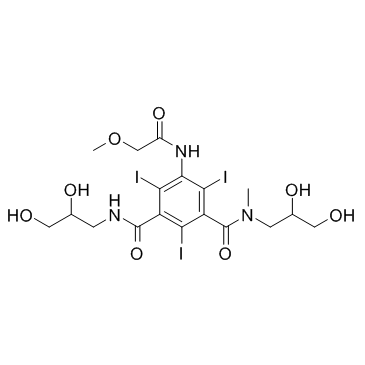iopromide

iopromide structure
|
Common Name | iopromide | ||
|---|---|---|---|---|
| CAS Number | 73334-07-3 | Molecular Weight | 791.112 | |
| Density | 2.2±0.1 g/cm3 | Boiling Point | 840.9±65.0 °C at 760 mmHg | |
| Molecular Formula | C18H24I3N3O8 | Melting Point | broad (160ºC transition) | |
| MSDS | USA | Flash Point | 462.4±34.3 °C | |
| Symbol |

GHS09 |
Signal Word | Warning | |
Use of iopromideIopromide is a water-soluble, non-ionic, monomeric, low-osmolar, iodine-based contrast medium for intravascular administration. |
| Name | iopromide |
|---|---|
| Synonym | More Synonyms |
| Description | Iopromide is a water-soluble, non-ionic, monomeric, low-osmolar, iodine-based contrast medium for intravascular administration. |
|---|---|
| Related Catalog | |
| In Vivo | Contrast medium-induced nephropathy can be induced by tail intravenous administration of iopromide[1]. In randomized controlled trials, the global image quality and diagnostic quality with iobitridol does not differ from those with other low-osmolar contrast media (iohexol, iopromide, iopamidol, iomeprol and ioxaglate) or the iso-osmolar contrast medium iodixanol in adults or children undergoing radiographic imaging. Large post-marketing surveillance studies have confirmed that iobitridol produces good or excellent opacification and is an effective contrast agent in the vast majority of patients. Iobitridol is generally well tolerated and had a tolerability profile similar to that of other low-osmolar and iso-osmolar contrast media. Thus, iobitridol is an effective intravascular agent for contrast enhancement in diagnostic imaging[2]. |
| Animal Admin | Mice: Male C57/BL6J mice are randomly divided into 7 groups: control, diabetes mellitus (D), CIN, diabetes mellitus+CIN (DC), diabetes mellitus+Breviscapine (DB), CIN+Breviscapine (CIN+B) and diabetes mellitus+CIN+Breviscapine (DCB). After the model of diabetes mellitus is established, mice are prohibited drinking water for one night, and then mice are injected at a dose of 10 mL/kg iopromide via tail vein administration over the course of 1 minute. Then the mice are treated intragastrically with or without Breviscapine (10 mg/kg/d) for 4 weeks. Other mice groups except for Breviscapine treatment groups (DB, DCB and CIN+B) are administered the same volume of phosphate buffered solution intragastrically for 4 weeks. Then mice are sacrificed by an intraperitoneal injection of chloral hydrate[1]. |
| References |
| Density | 2.2±0.1 g/cm3 |
|---|---|
| Boiling Point | 840.9±65.0 °C at 760 mmHg |
| Melting Point | broad (160ºC transition) |
| Molecular Formula | C18H24I3N3O8 |
| Molecular Weight | 791.112 |
| Flash Point | 462.4±34.3 °C |
| Exact Mass | 790.869690 |
| PSA | 168.66000 |
| LogP | -2.95 |
| Vapour Pressure | 0.0±3.3 mmHg at 25°C |
| Index of Refraction | 1.710 |
| Storage condition | Hygroscopic, -20?C Freezer, Under Inert Atmosphere |
| Stability | Hygroscopic |
CHEMICAL IDENTIFICATION
HEALTH HAZARD DATAACUTE TOXICITY DATA
|
|
~85% 
iopromide CAS#:73334-07-3 |
| Literature: LG LIFE SCIENCES LTD. Patent: WO2009/134030 A1, 2009 ; Location in patent: Page/Page column 11 - 12 ; |
| HS Code | 2924299090 |
|---|---|
| Summary | 2924299090. other cyclic amides (including cyclic carbamates) and their derivatives; salts thereof. VAT:17.0%. Tax rebate rate:13.0%. . MFN tariff:6.5%. General tariff:30.0% |
|
Adverse skin reactions to iodinated x-ray contrast agents in healthy rats.
Invest. Radiol. 49(12) , 779-87, (2014) The aim of this preclinical study on healthy Sprague-Dawley rats was to determine whether differences exist in the induction of adverse skin reactions after the intravenous administration of a monomer... |
|
|
Analysis of the roles of glucose transporter 1 and hexokinase 2 in the metabolism of glucose by extrahepatic bile duct cancer cells.
Clin. Nucl. Med. 40(3) , e178-82, (2015) Extrahepatic bile duct (EHD) cancer varies in uptake of FDG. The aim of the present study was to determine the role of glucose transporter (GLUT) 1 and hexokinase (HK) 2 in the glucose metabolism of E... |
|
|
Ventilation/perfusion mismatch during lung aeration at birth.
J. Appl. Physiol. 117(5) , 535-43, (2014) At birth, the transition to newborn life is triggered by lung aeration, which stimulates a large increase in pulmonary blood flow (PBF). Current theories predict that the increase in PBF is spatially ... |
| iopromide |
| N,N'-bis(2,3-dihydroxypropyl)-2,4,6-triiodo-5-[(méthoxyacétyl)amino]-N-méthylbenzène-1,3-dicarboxamide |
| N,N'-Bis(2,3-dihydroxypropyl)-2,4,6-triiodo-5-[(methoxyacetyl)amino]-N-methylisophthalamide |
| Ultravist |
| 1,3-Benzenedicarboxamide, N,N-bis(2,3-dihydroxypropyl)-2,4,6-triiodo-5-[(2-methoxyacetyl)amino]-N-methyl- |
| iopromida |
| 5-Methoxyacetylamino-2,4,6-triiodoisophthalic Acid [(2,3-Dihydroxy-N-methylpropyl)-(2,3-dihydroxypropyl)]diamide |
| N,N'-Bis(2,3-dihydroxypropyl)-2,4,6-triiod-5-[(methoxyacetyl)amino]-N-methylbenzol-1,3-dicarboxamid |
| iopromidum |
| N,N'-bis(2,3-dihydroxypropyl)-2,4,6-triiodo-N-methyl-5-{[(methyloxy)acetyl]amino}benzene-1,3-dicarboxamide |
| 1,3-benzenedicarboxamide, N,N'-bis(2,3-dihydroxypropyl)-2,4,6-triiodo-5-[(methoxyacetyl)amino]-N-methyl- |
| EINECS 277-385-9 |
| Ultravist 300 |
| N,N'-Bis(2,3-dihydroxypropyl)-2,4,6-triiodo-5-[(methoxyacetyl)amino]-N-methyl-1,3-benzenedicarboxamide |
| N,N'-bis(2,3-dihydroxypropyl)-2,4,6-triiodo-5-[(methoxyacetyl)amino]-N-methylbenzene-1,3-dicarboxamide |
| Ultravist 370 |
| UNII:712BAC33MZ |
| SHL 414C |
| 1-N,3-N-bis(2,3-dihydroxypropyl)-2,4,6-triiodo-5-[(2-methoxyacetyl)amino]-3-N-methylbenzene-1,3-dicarboxamide |
| MFCD00867924 |
![5-methoxyacetylamino-2,4,6-triiodoisophthalic acid [(2,3-dihydroxy-N-methylpropyl)-(2,3-diacetoxypropyl)]diamide structure](https://image.chemsrc.com/caspic/133/1193076-40-2.png)